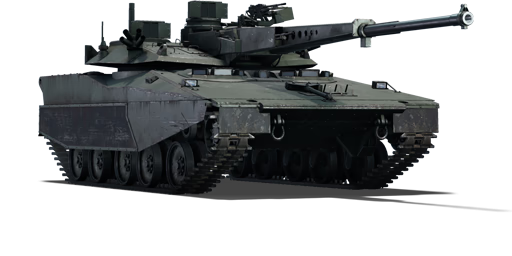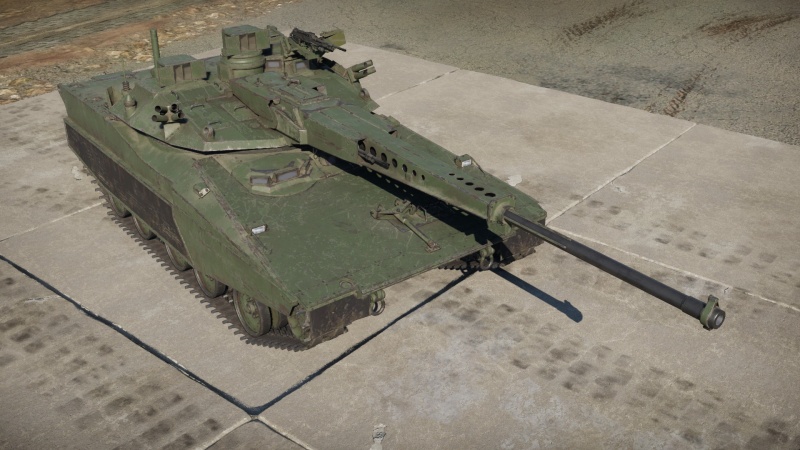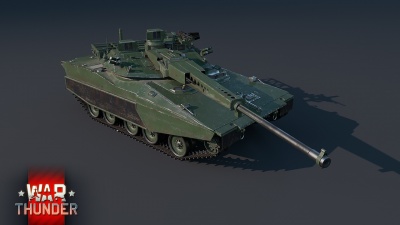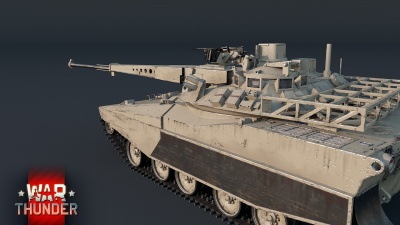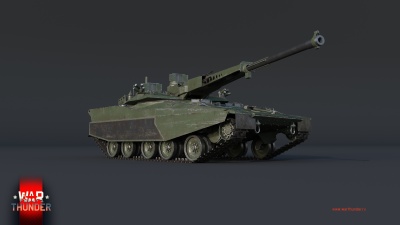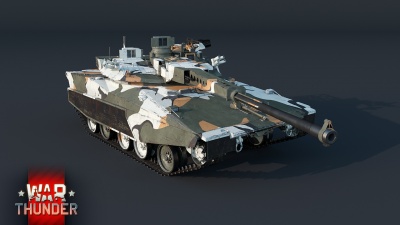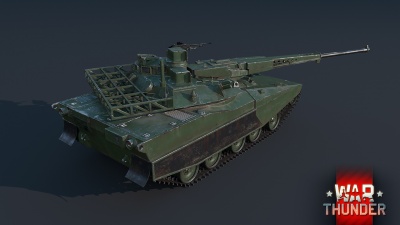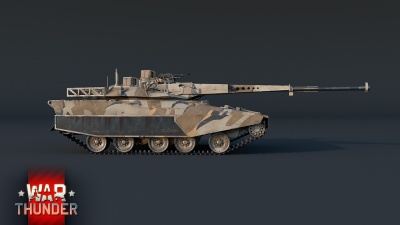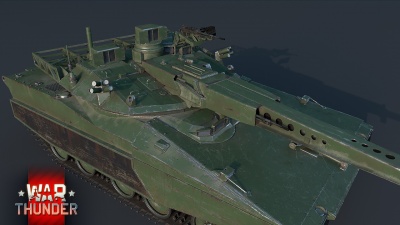Difference between revisions of "HSTV-L"
CobraKingII (talk | contribs) |
CobraKingII (talk | contribs) (→Survivability and armour) |
||
| Line 17: | Line 17: | ||
! Armour !! Front (Slope angle) !! Sides !! Rear !! Roof | ! Armour !! Front (Slope angle) !! Sides !! Rear !! Roof | ||
|- | |- | ||
| − | | Hull || 25.4 mm | + | | Hull || 25.4 mm (80°) ''Upper Glacis'' <br> {{annotation|25.4 mm|Estimated through calculation of effective thickness at angle.}} (55°) ''Lower Glacis (Upper Part)'' <br> {{annotation|25.4 mm|Estimated through calculation of effective thickness at angle.}} (78°) ''Lower Glacis (Lower Part)'' |
| − | | 19 mm '' | + | | 25.4 mm ''Upper Sponson Side'' <br> 19 mm ''Lower Sponson Side'' <br> 38.1 mm ''Lower Hull Side'' |
| + | | 25.4 mm || 19 mm ''Engine Compartment Roof'' <br> 5 mm ''Radiator Vents'' | ||
|- | |- | ||
| Turret || 25.4 mm ''Turret front'' <br>25.4 mm ''Gun mantlet'' || 25.4 mm || 25.4 mm || 25.4 mm | | Turret || 25.4 mm ''Turret front'' <br>25.4 mm ''Gun mantlet'' || 25.4 mm || 25.4 mm || 25.4 mm | ||
| Line 27: | Line 28: | ||
'''Notes:''' | '''Notes:''' | ||
| − | * | + | * Lower glacis (both parts) is variable thickness armour. |
| − | * | + | |
| + | {| class="wikitable" | ||
| + | |- | ||
| + | ! Additional Armour !! Front (Slope angle) !! Sides | ||
| + | |- | ||
| + | | Hull ||{{annotation|25.4 mm|Estimated through calculation of effective thickness at angle.}} (80°) ''Upper Glacis'' || {{annotation|25.4 mm|Estimated through calculation of effective thickness at angle.}} ''Frontal Sponson Side (Upper & Lower)'' <br> 12.7 mm ''Frontal Sideskirts'' <br> 8 mm ''Rear Sideskirts'' | ||
| + | |} | ||
| + | '''Notes:''' | ||
| + | * Upper glacis and frontal sponson sides appliqué armour is variable thickness armour. | ||
=== Mobility === | === Mobility === | ||
Revision as of 19:26, 23 February 2021
Contents
Description
The High Survivability Test Vehicle — Lightweight is a rank VII American light tank with a battle rating of 11.7 (AB/RB/SB). It was introduced in Update "Starfighters".
General info
Survivability and armour
The HSTV-L is a very lightly-armoured vehicle. The HSTV-L also has hull break, if any "solid" module were to get hit (e.g. gun breech or engine/transmission) the vehicle will be hull broken. Depending on where you get shot you might lose 1 crew member but you will still be alive. If you get shot on the left side of the vehicle from the front, the chances of your ammo rack detonating greatly increases. Best case scenario for this vehicle is to not get hit in the first place.
| Armour | Front (Slope angle) | Sides | Rear | Roof |
|---|---|---|---|---|
| Hull | 25.4 mm (80°) Upper Glacis 25.4 mm (55°) Lower Glacis (Upper Part) 25.4 mm (78°) Lower Glacis (Lower Part) |
25.4 mm Upper Sponson Side 19 mm Lower Sponson Side 38.1 mm Lower Hull Side |
25.4 mm | 19 mm Engine Compartment Roof 5 mm Radiator Vents |
| Turret | 25.4 mm Turret front 25.4 mm Gun mantlet |
25.4 mm | 25.4 mm | 25.4 mm |
| Cupola | 25.4 mm | 25.4 mm | 25.4 mm | 25.4 mm |
Notes:
- Lower glacis (both parts) is variable thickness armour.
| Additional Armour | Front (Slope angle) | Sides |
|---|---|---|
| Hull | 25.4 mm (80°) Upper Glacis | 25.4 mm Frontal Sponson Side (Upper & Lower) 12.7 mm Frontal Sideskirts 8 mm Rear Sideskirts |
Notes:
- Upper glacis and frontal sponson sides appliqué armour is variable thickness armour.
Mobility
| Game Mode | Max Speed (km/h) | Weight (tons) | Engine power (horsepower) | Power-to-weight ratio (hp/ton) | |||
|---|---|---|---|---|---|---|---|
| Forward | Reverse | Stock | Upgraded | Stock | Upgraded | ||
| Arcade | 93 | 28 | 20 | 1,007 | 1,240 | 50.35 | 62 |
| Realistic | 84 | 25 | 575 | 650 | 28.75 | 32.5 | |
The HSTV-L has a very good power-to-weight ratio making the vehicle decently fast. The vehicle utilizes a 648 HP gas turbine engine. The HSTV-L is very manoeuvrable due to the gas turbine engine and can get to flanking spots early in the game.
Modifications and economy
Armaments
Main armament
| 75 mm XM274 | Turret rotation speed (°/s) | Reloading rate (seconds) | |||||||||||
|---|---|---|---|---|---|---|---|---|---|---|---|---|---|
| Mode | Capacity | Vertical | Horizontal | Stabilizer | Stock | Upgraded | Full | Expert | Aced | Stock | Full | Expert | Aced |
| Arcade | 26 | -17°/+45° | ±180° | Two-plane | 54.3 | 75.1 | 91.2 | 100.9 | 107.3 | 1.5 | 1.5 | 1.5 | 1.5 |
| Realistic | 33.9 | 39.9 | 48.5 | 53.6 | 57.0 | ||||||||
Ammunition
| Penetration statistics | |||||||
|---|---|---|---|---|---|---|---|
| Ammunition | Type of warhead |
Penetration @ 0° Angle of Attack (mm) | |||||
| 10 m | 100 m | 500 m | 1,000 m | 1,500 m | 2,000 m | ||
| XM885 | APFSDS | 276 | 269 | 262 | 252 | 243 | 234 |
| Shell details | |||||||||
|---|---|---|---|---|---|---|---|---|---|
| Ammunition | Type of warhead |
Velocity (m/s) |
Projectile Mass (kg) |
Fuse delay (m) |
Fuse sensitivity (mm) |
Explosive Mass (TNT equivalent) (g) |
Ricochet | ||
| 0% | 50% | 100% | |||||||
| XM885 | APFSDS | 1,463 | 2.2 | N/A | N/A | N/A | 78° | 80° | 81° |
Ammo racks
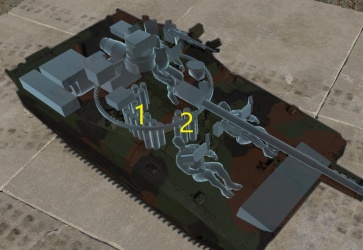
| Full ammo |
1st rack empty |
2nd rack empty |
Visual discrepancy |
|---|---|---|---|
| 26 | 7 (+19) | 1 (+25) | No |
Notes:
- Rack 2 is a ready rack, so although shells deplete from that rack after firing, it will refill from rack 1.
Machine guns
The HSTV-L has 2 M240 machine guns. One is fixed to the gun mantlet and the other is mounted on the Commander's cupola. These machine guns can be used to mark enemies for your allies and can also be used to shoot down some lighter aircraft, but be careful as shooting them will give away your location and can result in them strafing and destroying your vehicle.
| 7.62 mm M240 | ||||
|---|---|---|---|---|
| Mount | Capacity (Belt) | Fire rate | Vertical | Horizontal |
| Coaxial | 1,600 (200) | 941 | N/A | N/A |
| Pintle | 1,600 (200) | 941 | -10°/+69° | -180°/+20° |
Usage in battles
The HSTV-L is a light tank with a quick ready-rack reload, making it adept at dealing with multiple enemies in ambush situations. It can achieve a very good top speed thanks to its light weight and has a similarly good turning ability. With this mobility (which is on par with that of top MBTs), the HSTV-L can achieve desirable early-game positions and move quickly around the map when necessary.
Like most light tanks, this vehicle is lacking in the protection department. It has thin armour in all directions, which is not backed up by any spaced or composite protection, and is susceptible to hull-break. In some situations, the armour may be thin enough that kinetic rounds overpenetrate and pass straight through the vehicle without causing much damage. The highly-angled armour can also sometimes bounce shots. In most cases though, the HSTV-L cannot be counted on to sustain heavy fire.
This tank is fairly unique in that it is equipped with an autoloader with a 6-round ready-rack. This means that the first 6 shots fired from the HSTV-L can come in very rapid succession--the reload time for these shells is a mere 1.5 seconds. After these first rounds, the ready-rack is empty and the reload time increases dramatically. The player must take this into account when deciding which enemies to engage. The HSTV-L can pull off short bursts of high firepower, but needs time to replenish its ready-rack. The shell itself, an APFSDS round, is decent, but may have trouble penetrating the frontal armour of top MBTs. This combined with the vehicle's poor armour means that head-on attacks are rarely advisable.
The HSTV-L is better suited to firing at enemies without their noticing--from ambush positions, from the flanks, and from behind corners. The vehicle's great mobility will aid with this playstyle. Indeed, its mobility is what makes the HSTV-L great on urban maps. Furthermore, in ambush situations the tank is able to easily deal with multiple enemies thanks to its fast ready-rack reload. This tank has a 45 degree gun elevation and a 17 degree gun depression. This gun depression is extremely powerful, and makes the vehicle very effective at hill camping and at firing from behind ridgelines. A thermal sight in both gunner and commander/binocular views makes the HSTV-L a great scouting vehicle. It is recommended to use the vehicle's high mobility to aid in scouting enemies for teammates to locate and destroy.
Pros and cons
Pros:
- The cannon has a very good ROF with a 1.5s reload
- Due to its light armour, some kinetic rounds may over penetrate, leaving it untouched
- Excellent urban fighting vehicle as in up-tiers, side shots are much more effective
- Internal 30 mm armour can help protect crew
- Thermal sight for both gunner and commander = Great scouting vehicle
- Up to 45° elevation and -17° depression.
- Very good gun handling
Cons:
- As with all light vehicles, it is susceptible to the "Hull Break" mechanic
- Commander's cupola can be penetrated by heavy machine gun fire
- Limited ammo, at only 26 rounds
- Extremely poor ammo selection; can only fire APFSDS
- APFSDS round has problems penetrating frontal armour of later MBTs
- The APFSDS shell is designated as short-rod, causing minimum damage after penetration
- The cannon has relatively low penetration
- Average mobility even with 32hp/t and low ground pressure
History
Development
The High Survivability Test Vehicle - Lightweight, shortened to HSTV-L, was a light tank project that was developed in the 1970’s and 1980’s. It was funded by the Defense Advanced Research Projects Agency (DARPA) and built by the AAI Corporation. The prototype was completed in September 1979 and began field trials soon after. After the field trials the HSTV-L was used for testing of the fire control system (FCS) with different stabilization algorithms tested as well as the hunter-killer sights. The HSTV-L was not chosen for production by the Army or the Marine Corps and was cancelled in 1981. It was later developed into the Rapid Deployment Force Light Tank (RDF/LT).
Design
General
The HSTV-L design was based around an incredibly low profile hull and turret with very shallow angles on the frontal portion, in order to deflect projectiles fired at it. The HSTV-L had a crew of 3, with the driver and gunner side by side in the hull front and the commander in the left side of the turret, all of whom sat semi-reclined. All 3 crew members had the ability to fire the gun and both the gunner and driver’s position could drive the vehicle. The vehicle had a length of 8.528 m with gun forward and the hull had a length of 5.918 m. The height was only 2.414 m including the equipment on the turret roof, being 1.994 m to the top of the turret and 1.422 m to the top of the hull. The width was 2.794 meters. The vehicle had a combat weight of 14.5 tonnes or up to 17.0 tonnes when equipped with an appliqué armor package. During testing the HSTV-L was fitted with additional equipment for data collection and weighed 20.45 tonnes. The HSTV-L could be airlifted, underslung, by a CH-53 Sea Stallion helicopter when at the weight of 14.5 tonnes.
Mobility and Power
The HSTV-L was propelled by a 650 horsepower (485 kilowatt) Avro-Lycoming gas turbine powerplant and an Allison X-300-4A transmission with four forward and one reverse gear. There were five road wheels on each side and the tracks were 450 mm wide. The suspension was built by National Water Lift, being hydropneumatic but not variable; in other words the height could not be adjusted. The ground clearance of the HSTV-L was 0.508 meters. The HSTV-L could pivot in place while in neutral gear, and it carried a fuel load of 409 liters giving it a cruising range of 160 kilometers. It could accelerate from 0 to 48 kph in 11.8 seconds and had a maximum speed of 83.68 kilometers per hour.
In addition to the main propulsion system there were two 250 ampere generators providing auxiliary power as well as a 60 gpm hydraulic pump. The hydraulic pump was used to power an oil cooler fan mounted in the engine compartment as well as the gun control system and automatic loading system.
Armament and FCS
The main armament of the HSTV-L was an ARES 75 mm XM274 gun mounted in a rotating turret. 26 rounds of ammunition were provided of both depleted-uranium APFSDS-T and multi-flechette anti-aircraft rounds. The gun was loaded by an automatic loading system which provided the HSTV-L with a high rate of fire.
Secondary armament was provided by a coaxial 7.62 mm M240 machine gun and a second 7.62 mm M240 machine gun pintle-mounted on the commander’s cupola. A total of 3,200 rounds of 7.62 mm ammunition was split between the two machine guns.
The turret could rotate a full 360 degrees at a speed of 57 degrees per second. The gun could elevate 45 degrees but the depression depended on which direction the turret faced; over the front the gun could depress 17 degrees, 30 degrees over the side, and 6 degrees over the rear of the vehicle. Manual backup was provided for turret traverse and gun elevation but the rate at which they moved was much slower when manual than with power. The main gun was two-plane stabilized, with both the stabilization and gun control systems having been produced by Cadillac Gage.
The hunter/killer fire control system (FCS) was designed and built by Texas Instruments. The commander received a stabilized commander’s independent thermal viewer (CITV) which could rotate independently of the turret and included both TV and thermal imaging. The gunner also received a stabilized sight, though this one was slaved to the gun, which included thermal and TV imaging as well, along with an eye safe CO2 laser rangefinder built by Raytheon. This hunter/killer system allowed the commander to locate a target with the hunter sight. Once a target was located the gunner would use his killer sight to fire on the target while the commander began to search for the next target. The fire control system (FCS) used the sights, crosswind sensor, muzzle reference system, vertical reference system, and laser rangefinder to automatically determine the firing solution, leaving the gunner only to fire the gun. The fully stabilized main gun along with advanced FCS allowed the HSTV-L a high first hit probability and high accuracy on the move.
The driver and gunner are given a screen that displays the imaging of the hunter sight which allows them to operate independently of a vehicle commander if necessary. Theoretically, the HSTV-L could be controlled entirely by only one crew member from either the driver or gunner’s position since both had driving and gunnery controls.
Devblog
By the mid 1970’s, the US military initiated a series of studies which looked into the development of new concepts and designs for tanks which combined good firepower and survivability. The latter of which was to be achieved through a smaller size, rather than heavy armor protection.
As at the time, both the US Army and USMC were looking into possible replacements for their M551 Sheridan and M50 Ontos tanks respectively, the two military branches joined forces in a joint research programme dubbed “ARMVAL” (Advanced Antiarmor Vehicle Evaluation). The vehicles developed under this programme would be used as test beds for various new concepts and ideas in an effort to gain new experiences, which would in turn be used in the development of future tank designs.
One of the later products of this experimental programme was the HSTV-L - a compact, lightweight, highly mobile tank design, fitted with an autoloaded 75mm smoothbore cannon, designed to fire kinetic ammunition in short bursts in order to wear down and ultimately defeat composite armor screens. The HSTV-L was built in 1979 and underwent various trials until 1981.
At the start of the 1980’s, the 75mm gun was considered inadequate to deal with the most recent Soviet MBTs by the Army, while the USMC questioned the vehicle’s effectiveness in amphibious landing operations. This led to the ultimate discontinuation of the collaborative project in 1981.
Media
- Skins
- Videos
See also
- Tanks at similar positions in other tech trees:
- VFM 5 - A British light tank
- CV90105 TML - A Swedish light tank
- TAM 2C - A German light tank
- Object 685 - A Russian light tank
External links
| Aircraft Armaments Incorporated (AAI) Corporation | |
|---|---|
| Light tanks | T92 · HSTV-L |
| USA light tanks | |
|---|---|
| LVT | LVT(A)(1) · ○LVT(A)(1) · LVT(A)(4) |
| M2 | M2A2 · M2A4 · M2A4 (1st Arm.Div.) |
| M3/M5 Stuart | M3 Stuart · M3A1 Stuart · M3A1 (USMC) · M5A1 · M5A1 TD · ▃Stuart VI (5th CAD) |
| M22 Locust | M22 |
| M24 Chaffee | M24 · M24 (TL) |
| M18 Hellcat | M18 GMC · M18 "Black Cat" · Super Hellcat |
| M41 Walker Bulldog | M41A1 |
| M551 Sheridan | M551 · M551(76) |
| M3 Bradley | M3 Bradley · M3A3 Bradley |
| Wheeled | M8 LAC · T18E2 · M1128 · M1128 Wolfpack |
| Other | M8A1 GMC · T92 · T114 · HSTV-L · CCVL · XM8 · XM800T · AGS |


